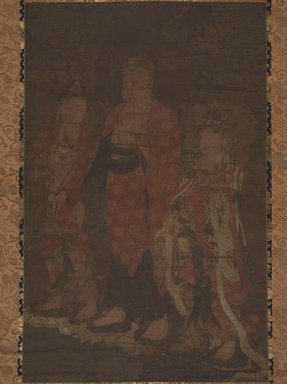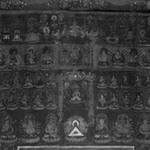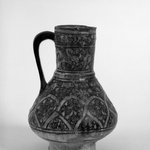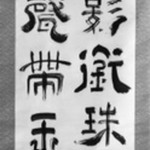Amit'a Triad
Asian Art
MEDIUM
Ink, color and gold on silk
DATES
14th century
DYNASTY
Goryeo Dynasty
DIMENSIONS
51 1/4 x 32 1/4in. (130.2 x 81.9cm)
With mounting: 96 1/16 x 40 3/16 in. (244 x 102 cm)
(show scale)
ACCESSION NUMBER
61.204.30
CREDIT LINE
Gift of Professor Harold G. Henderson
CATALOGUE DESCRIPTION
This impressive image, considered one of the premier Goryeo paintings in the United States, depicts the Buddha Amit'a (Sanskrit: Amitabha), accompanied by two bodhisattvas: Kwan'um (Sanskrit: Avalokiteshvara) on the right and Seishi (Sanskrit: Mahasthamaprapta) on the left. Amit'a, the ruler of the Western Paradise, is the main icon of the Pure Land Sect of Buddhism, an extremely popular cult in Korea during the Goryeo dynasty.
The position of Amit'a and the two bodhisattvas, standing diagonally on a lotus flower, suggests that they are on their way to this world to welcome their followers. Considering that there are several Goryeo examples of this painting with similar composition and scale, it is highly possible that a model for this type of painting existed earlier. In other images, Amit'a is seated on a throne flanked by two, four, or eight bodhisattvas.
The scroll is painted on closely woven silk, now dark brown in color. The Amit'a stands, wearing brown and red robes, touched with gold medallions, at center, with each foot on lotus pods. He is nimbate, and his left hand is raised in the abhaya mudra and his right is held in varada mudra. The figure to his left, the Bodhisattva Avalokiteshvara, also stands on lotus pedestals, wears bright brocade garments with jewels, and holds a long stem of a lotus. the figure to the right of Amit'a, is also elaborately dressed with long sashes and carries a willow branch in his left hand and a vase in his right hand. The two attendant bodhisattvas are nimbate. The ground is a dark brown. Some of the pigments have darkened and the drapery lines appear to have been redrawn. Arrived with its own box, with box inscription.
Produced with a dazzling technical virtuosity, Goryeo (918-1392) Buddhist paintings are renowned for their magnificent quality. Colors in dark tones, applied gold pigment and meticulously expressed details characterize works of this period. Only about 100 Goryeo Buddhist paintings survive worldwide, with fewer than ten paintings housed in Korea. Over seventy percent of these works are in Japanese collections, most of them having arrived in Japan from the 13th through 16th centuries, and now owned by temples.
This Amitabha Buddha Triad depicts standing Amitabha Buddha flanked by two bodhisattvas, Avalokitesvara and Mahastamaprapta. Goryeo paintings of Amitabha welcoming souls reborn in his paradise typically depict the Buddha riding on clouds, descending to the dying creature in this world. In this particular painting, however, there is no cloud under his feet. Here Amitabha and Avalokitesvara are drawn in profile, whereas Mahasthamaprapta's face is drawn in full. The principal Buddha displays a symbolic hand gesture, forming circles with the thumb and middle forefinger of each hand, although the left hand is raised up to the chest while the right is lowered down. His head features a distinctive "tri-peak" shape combined with a crown (usnisa) and "topknot jewel." There is a Buddhist swastika drawn in gold on the chest.
A part of the brown ground of the painting has peeled off and reveals the cloth underneath, but the red is quite vivid against the green, which has been much defaced by time. The gold lines drawn over the pastel tones of pink, blue, brown, and white, among others, have kept much of their original luster. The arrangement, posture, clothing and symbolic objects of the figures, including the long floral necklace, have lead art historians to believe that the painting is based on the same model used for the Amitabha Buddha Triad paintings collected by Senoku Hakkokan, Hodoji, and an individual collector in Japan. In this particular work, part of the peeled painting surface shows vividly the elegant ink lines hidden underneath. The facial expressions exhibiting the mysteriously serene inner world, the tall but nicely voluminous body, luxuriously beaded ornaments, and the distinctive pastel-tone coloring together create an exalted atmosphere that makes Goryeo Buddhist paintings great works of art. There is a postscript, "Written by Zhang Sigong" inside the lid of the wooden box. Experts believe that it was written at a later date.
From "Korean Art Collection in the Brooklyn Museum" catalogue.
MUSEUM LOCATION
This item is not on view
CAPTION
Amit'a Triad, 14th century. Ink, color and gold on silk, 51 1/4 x 32 1/4in. (130.2 x 81.9cm). Brooklyn Museum, Gift of Professor Harold G. Henderson, 61.204.30 (Photo: , 61.204.30_PS9.jpg)
IMAGE
overall, 61.204.30_PS9.jpg., 2017
"CUR" at the beginning of an image file name means that the image was created by a curatorial staff member. These study images may be digital point-and-shoot photographs, when we don\'t yet have high-quality studio photography, or they may be scans of older negatives, slides, or photographic prints, providing historical documentation of the object.
RIGHTS STATEMENT
No known copyright restrictions
This work may be in the public domain in the United States. Works created by United States and non-United States nationals published prior to 1923 are in the public domain, subject to the terms of any applicable treaty or agreement.
You may download and use Brooklyn Museum images of this work. Please include caption information from this page and credit the Brooklyn Museum. If you need a high resolution file, please fill out our online
application form (charges apply).
The Museum does not warrant that the use of this work will not infringe on the rights of third parties, such as artists or artists' heirs holding the rights to the work. It is your responsibility to determine and satisfy copyright or other use restrictions before copying, transmitting, or making other use of protected items beyond that allowed by "fair use," as such term is understood under the United States Copyright Act.
The Brooklyn Museum makes no representations or warranties with respect to the application or terms of any international agreement governing copyright protection in the United States for works created by foreign nationals.
For further information about copyright, we recommend resources at the
United States Library of Congress,
Cornell University,
Copyright and Cultural Institutions: Guidelines for U.S. Libraries, Archives, and Museums, and
Copyright Watch.
For more information about the Museum's rights project, including how rights types are assigned, please see our
blog posts on copyright.
If you have any information regarding this work and rights to it, please contact
copyright@brooklynmuseum.org.
RECORD COMPLETENESS
Not every record you will find here is complete. More information is available for some works than for others, and some entries have been updated more recently. Records are frequently reviewed and revised, and
we welcome any additional information you might have.











































